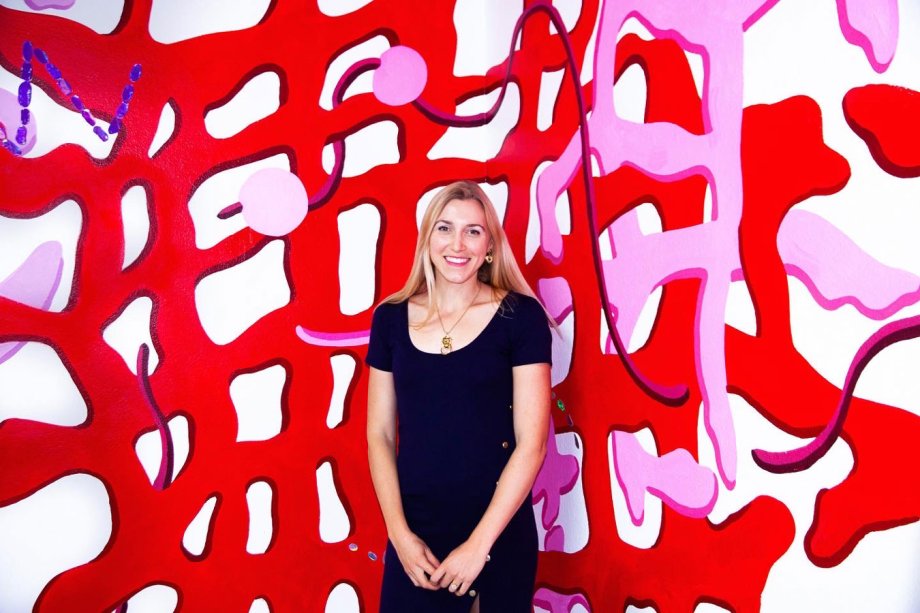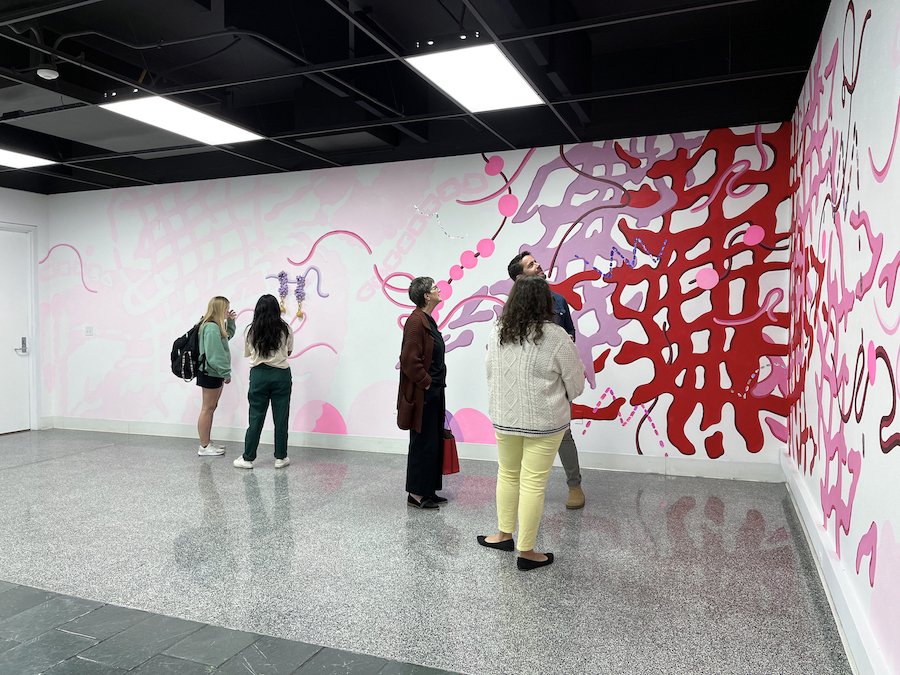
Artist-in-Residence (AiR) programs are commonplace at universities across the country and provide artists ample time to create and explore their work. Recently, researchers at South Dakota State University took an in-depth look at the School of Design’s AiR program to learn what impact it may have on the creative behaviors of art and STEM major students.
Stuart Artist-in-Residence program
Each fall, the school invites a working artist to campus as part of the Stuart Artist-in-Residence program. For one month, the AiR interacts with students through lecture, critique, open studio hours and an open studio event.
In fall 2022, Ali Hval, a visual artist from Iowa City, Iowa, was SDSU's AiR. Hval's art is multidisciplinary and combines ceramic, fabric, installation and painting.
The Stuart Artist-in-Residence program, which started in 2015, is funded and named after Joe and Signe Stuart, who lived, worked and taught in Brookings for several decades. Joe served as the director and curator for the South Dakota Art Museum while Signe was an art professor at SDSU between 1972 and 1994.
Joe appreciated art in all forms but was a champion of modern and contemporary art and worked to create opportunities for regional artists throughout his career. His work at the museum made a foundational impact on the body of the institution and his legacy lives on through his sensitive curation of acquisitions for the museum.
Signe is currently an active artist who resides in Sante Fe, New Mexico. Her professional history spans more than 50 years, and her work has been shown in 18 solo museum exhibitions and many other museum group exhibitions. A retrospective of her work will open at the South Dakota Art Museum later this year. Locally, collections of her work can be seen in Sioux Falls at the Washington Pavilion and the Sioux Falls Regional Airport.
The Stuarts initiated the development of an artist-in-residence program to enrich the community of Brookings and create opportunities for students and faculty to interact with artists currently residing and working outside and beyond the South Dakota region.
Assessing the impact of the AiR program
Prior to Hval's arrival, the School of Design received a $35,000 grant from the National Endowment for the Arts (NEA) to investigate art and design students' enhanced creative behaviors following participation in the AiR program.

The project, titled "Letting the AiR Out: Assessing the impact of an artist-in-residence program on college students in arts and STEM fields," was to fill in a knowledge gap of what impact AiR programs have on higher education curriculum, or on creativity in the social science disciplines. Previous research funded by the NEA had focused primarily on K-12 education and the impact of AiR programs on the artist themselves.
The team of researchers included Elizabeth Tofte, an assistant professor in the School of Design; Tyler Miller, an associate professor and associate director in the School of Psychology, Sociology and Rural Studies; School of Design Director Pat Crawford; and School of Design Associate Director Leda Cempellin.
They assessed students who participated and interacted with Hval with pre- and post-program surveys. The researchers wanted to gain a better understanding of how operationalized art provides students with alternative pedagogy to strengthen their creative behaviors.
“We are looking at the impact the program has on students who interacted with the artist,” Tofte explained.
During Hval's monthlong stay, she provided numerous opportunities for students to interact with her and ask questions. The first was a lecture, which occurred at the very beginning of the stay, followed by open studio hours throughout the month in Grove Hall. At the end of her stay, there was a presentation followed by a reception in which students, SDSU faculty and community members attended.
"It was really rewarding to work with students, especially undergraduate students, because I get to return to talking about the basics of my work," Hval said. "I remember one class that was brought into my workspace was like an illustration or a color theory class. They came in and they started asking me different questions about why I am using the colors that I'm using, and it really sort of makes you remember—and makes you question—things that seem really simple, but they're also very important."
The researchers used the Biographical Inventory of Creative Behaviors, a checklist of self-reported measures of creative behaviors that was developed by Mark Batey in 2007, to track students’ creative behaviors over time. They were also looking to assess students’ intentions to engage in creative behaviors in the future.
Over 600 valid (300 pre and 309 post) surveys were gathered for analysis. Later in the semester, students who had at least one interaction with Hval were invited to reflect on their experiences and the effect it had on their perceived creativity.
It was found that students who interacted with Hval were more likely to engage in creative behaviors.
"Students who engaged with the AiR artist and program had more favorable attitudes toward creative behaviors," Miller said.
Further, it was concluded that students were more likely to engage in creative behaviors in the future, following participation in the AiR program.
"We observed that students were able to reflect and articulate on their own learning experiences," Tofte said.
An analysis of the responses found that following interactions with Hval and participation in the AiR program, students were able to better explain their art to other people. Students also gained a better understanding of how to make art on difficult topics. Finally, the program helped them how to figure out how to find inspiration for their work.

Hval month
During the spring 2023 semester, faculty members in the School of Design got a surprise. Student-leaders in SDSU's Graphic Design Club initiated and organized a monthlong celebration of Hval.
"This was a great idea by the graphic design students," Tofte said. "But it came as a total surprise to us in the School of Design."
The students held weekly workshops that recognized Hval's influence on their newfound ways of creating art. According to Bev Krumm, a former graphic design instructor, 17 art major students and 7 non-art major students spent four separate evenings making art in honor of Hval.
"Some of the pieces the students made were accurate copies of Ms. Hval's work, while other students used Ms. Hval's technique," Krumm said. "This was evidence to me that the students had successfully engaged with the AiR program."
Of those who participated in the workshops, four were from STEM disciplines. The rest were from art-centered majors.
"(The STEM students) enjoyed the comradery offered by the event and experienced a sense of accomplishment as they crafted lifelike replicas of their favorite small animals," Krumm said. "Five serious Hval devotees crafted brightly colored ceramic pieces with political undertones or social justice messages."
The study results, coupled with the follow-up workshops, provided evidence to the researchers that the AiR program had a measurable impact on the students. The AiR program will continue in fall 2023 with another monthlong residency from a new artist.
- Contact:
- Telephone number: 605-688-6161
Republishing
You may republish SDSU News Center articles for free, online or in print. Questions? Contact us at sdsu.news@sdstate.edu or 605-688-6161.

